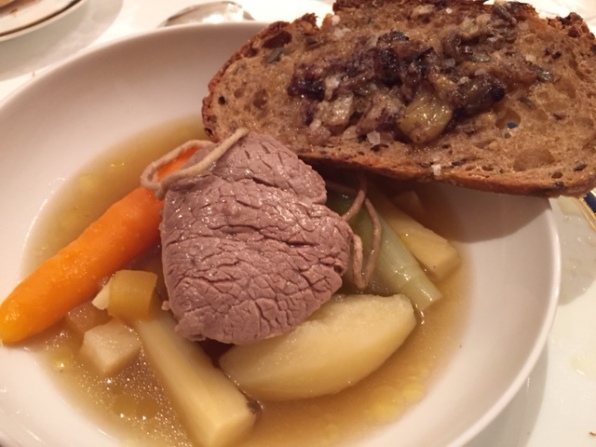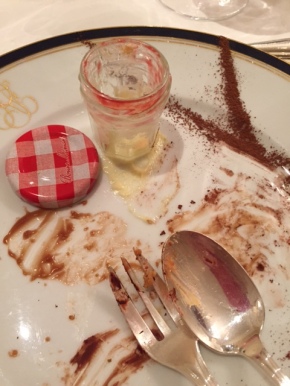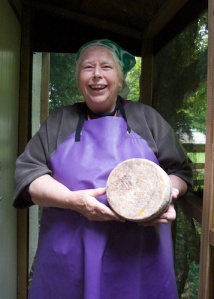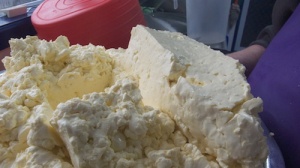This being Cheese Month, NZ Life & Leisure has posted a feature story I wrote about Mt Eliza Cheese last year. Great pics by Simon Young. Click to read
Archive for the ‘Cheese’ Category
Mt Eliza Cheese
Posted in Cheese on October 14, 2016| 1 Comment »
Give NZ Cheese a Chance
Posted in Cheese, Food politics on October 13, 2016| 6 Comments »
I spent the morning at the Beehive today in support of artisan cheesemakers Biddy Fraser-Davies (Cwmglyn Farmhouse Cheese) and Jill Whalley (Mt Eliza Cheese). The three of us presented submissions to the the Primary Production Select Committee who are labouring over the NZ Food Safety Reform Bill. The proposed reforms are a reaction to Fonterra’s whey protein contamination scare back in 2013. The bill aims to tighten the regulatory framework.
Biddy and Jill gave compelling accounts of the costs they already face in complying with laws designed for the big dairy companies. My submission outlined the reasons why we need to support our artisan cheesemakers.

Jill and Biddy pose for MPs and their iphones after demonstrating the different regulatory standards for NZ and European raw milk cheeses
My verbal submission as follows:
I am a former food manufacturer, now a journalist and food writer. For the past 15 years I’ve written and made feature stories about New Zealand’s artisan producers – including many who operate in the dairy sector. In light of the proposed tightening of our Food Safety laws I want to speak in support of the small scale cheese makers who are already suffering from the significant costs and constraints of the current regulations. I know many of them are too intimidated to speak for themselves
I’ve stood alongside Biddy and Jill and Chris Whalley as they make their cheese and I can tell you they are good operators – their premises are spotless, they know the science, they monitor, test and record every step of the process, and they produce very good, characterful cheese – cheese that New Zealanders can be proud of.
New Zealand is the world’s leading dairy exporter. Milk, butter and cheese: it’s how the world sees us – and yet our food safety laws make it nearly impossible for our artisan dairies to operate. Listen to the submissions today and you’ll wonder how these businesses make any money at all. I believe we are reaching a tipping point – by trying to eliminate risk we risk losing the artisan sector.
We need these small businesses to succeed because they do what the big companies don’t. They innovate, they set trends, they test the market, and the big companies follow.
You see it across all food categories – craft beer, artisan bread, coffee, ice cream, even butter (thanks to Lewis Rd).
I speak from experience having introduced fresh pasta to New Zealand many years ago. We started small, built the business over several years (with no food safety issues) then sold it to a multi-national who saw value in further developing the category. It’s now mainstream.
Could we have built that business under the current and proposed food safety regulations? Given the compliance costs, I don’t think so. Neither, I suspect, would Kapiti Cheese who started at the same time. They’re now owned by Fonterra. That’s how it works in the food industry. Small companies innovate, big companies follow, or take over.
So I find it strange that on the one hand we talk about the need to add value to our dairy industry and on the other hand we pass laws that make it extremely difficult for people to do so. Bills such as this one will continue to stifle innovation – to the detriment of the industry as a whole.
Without the artisans we wouldn’t be making goat and ewe’s milk cheeses – products with enormous potential. Without people like Biddy and JIll we wouldn’t be making raw milk cow cheese, so why do we insist their cheeses meet a much higher standard than raw milk cheese imported from Europe? Where is the sense in that?
Of course we need to keep our food safe but this is risk management gone mad. It’s paranoid and it’s unfair. If Fonterra had to pay more than 40% of their revenue in compliance costs – as Biddy will this year – they’d be screaming, and the regulators would be making more than the producers.
It’s high time that dairy scientists and MPI got together with the specialist cheesemakers to work out a sensible validation and testing regime that’s appropriate to the scale of their smaller non-export businesses. And then maybe their compliance costs could be subsidised by the bigger dairy companies who stand to gain the most from a well-supported artisan sector.
As you go through this Food Safety Reform bill, clause by clause, put yourselves in the shoes of small businesses who want to create new products, and try to strike a balance between the need to minimise risk and the need to create an environment that fosters the sort of innovation that will add value to our most important primary industry.
Goût de France, Wellington
Posted in Cheese, Food Events, France on March 23, 2016| 2 Comments »
The celebratory dinner hosted by the French ambassador Florence Jeanblanc-Risler in Wellington on Monday night (21/3/16) was everything I love about French dining. Beginning with an aperitif and polite conversation, we moved to tables graciously set with a regiment of silver, and proceeded to work our way through an elegant procession of dishes representing the best of French cuisine.
The occasion was the launch of Goût de France, an annual event (now in its second year) that celebrates French gastronomy in various restaurants worldwide. It’s all about honouring the legacy of the greats – we toasted Carême, Escoffier, Vatel, Brillat-Savarin – and recognising the techniques and ingredients that remain the backbone of contemporary French cuisine.
In New Zealand eight restaurants are combining local ingredients with French inspired recipes this week (commencing 21/3/16) – Hippopotamus, Jano Bistro and Whitebait in Wellington. Bracken in Dunedin. Hopgood’s in Nelson, Kazuya and The Grove in Auckland, and Pacifica in Napier.
Each will bring their own style to the event. The Wellington menu was fairly traditional, as befits an embassy occasion. The ambassador’s chef Fabien Le Gall worked with former embassy chef Veronique Sauzeau (now Le Marché Francais) and Laurent Loudeac (Hippopotamus Restaurant) on a six course menu beginning with consommé and ending with chocolat. French and New Zealand wines accompanied each course.

Entrée of salmon, three ways
Laurent’s signature dish of Aoraki salmon served trois façons (ie, confit, tartare and wood smoked) was followed by a classic pot au feu (tenderly poached filet de boeuf in bouillon with ‘forgotten’ vegetables and a dash of truffle oil). It came with toasted walnut bread that was slathered with bone marrow and salt crystals – it was the perfect rustic counterpoint to the refined bouillon and I confess I had to dunk it. Discreetly, I think.

Pot au Feu, filet de boeuf
The dessert was a degustation of chocolate – crowned for me by a dark chocolat ganache with a sliver of candied orange peel.
The cheese course was magnificent: an oven baked Mont d’Or with sautéed oyster mushrooms and crispy fried parsley to garnish.

Baked Mont d’Or, Vacherin
We broke through the crust and took it in turns to spoon the melted cheese on to our plates. It was unctuous. No one does cheese like the French. Ripe and savoury, sensual, sophisticated – it was un vrai goût de France.

…the end.
Vichyssoise my Whey
Posted in Cheese, Recipe on November 6, 2011| 1 Comment »
I remember my mother serving vichyssoise at dinner parties in the early 70s. The very name made it sound ‘continental’ and the fact it was served cold made it vogueishly different. She used to tell a story about a society hostess she knew in England who ran out of chives on one occasion and in a last minute panic garnished her vichyssoise with grass clippings. Her guests weren’t fooled but they were too polite to say and she thought she’d got away with it. In fact she was the subject of much hilarious gossip for sometime afterwards.
I’d always assumed the soup was invented in Vichy and I imagined high-ranking nazis ordering it in restaurants during the Occupation. Apparently not. According to Wiki it was created in 1917 by Louis Diat the chef at the Ritz-Carlton in New York who had fond memories of pouring cold milk into his mother’s hot leek and potato soup. A much better story.
A classic vichyssoise is the easiest soup to make – leeks, potatoes, chicken stock and cream – but my version is somewhat different and calls for an ingredient that’s not at all easy to come by. I’ve discovered that vichyssoise is a great way to make use of the whey that’s left over from a home cheese-making session. I got the idea from Katherine Mowbray who, during a course I attended, suggested using whey in soups such as leek and potato. Since I only ever make goats’ cheese, I thought I’d try to make a cold soup with goats’ milk whey. It was fantastic and, I think, quite original. The thing about a classic vichyssoise is the way it combines rustic earthiness with chilled sophistication. Substituting goats’ whey adds another dimension. It’s a subtle goatiness that’s elegant, not at all overpowering. I guess you could use cow or sheeps’ milk whey (even buffalo) and you’d get a slightly different result but – as I say – I only make goats’ cheese so other variants are untested.
I know people complain like mad if a recipe’s published and they can’t get the ingredients, so you’re not likely to see this in a magazine but if you do happen to get hold of some whey, here it is: Vichyssoise my Whey. I’ve also served it in shot glasses with a drop of cream and a snip of chives (never grass) to garnish. And if anyone does make it with whey from another type of milk, I’d love to hear about it.
Vichyssoise au Chèvre
50g butter
3 medium leeks, white part only, sliced thinly
3 medium potatoes, peeled and cut into chunks
1 teaspoon salt
white pepper to taste
1 bay leaf
1.5 litres goats’ milk whey
1 cup water
cream (or sour cream) and chives to garnish
Melt butter in a large pot and sweat leeks over medium-low heat for about 10 minutes until soft, stirring occasionally to prevent browning. Add potatoes, salt, pepper, bayleaf, whey and water. Bring to boil, reduce heat and simmer for about 30 minutes until potatoes are soft. Remove from heat. Extract bayleaf then puree soup in a blender.
Serve cold with a splash of cream or a blob of sour cream and a few snippets of chive.
Making Cheese with Biddy
Posted in Cheese, Food Hero, Review on October 30, 2011| 4 Comments »
I first met Biddy Fraser-Davies back in 2005 when I wrote about her for Cuisine magazine and produced a farming feature for Radio New Zealand. In those days she’d just started producing cheese on her farmlet and no one had heard of her or her much-loved cow, Gwendolyn. She was a real find, great talent with a no-nonsense approach and a cheerful eccentricity that fit her as comfortably as her bright pink crocs. Since then she’s starred on Country Calendar and been written up by numerous magazines and newspapers. Biddy and her milking cows – currently Sally and Molly – are the poster girls of the artisan cheese movement, and, as befits their celebrity status, they’ve just released their own DVD.
It’s called Farmhouse Cheese Making: an instructional DVD showing how Cwmglyn Farmhouse Cheese is produced. It features Molly the cow on the cover and stars Biddy the dairymaid in apron and boots. A self-taught cheesemaker, she begins by admitting it took her a full year of trial and error to achieve the consistently good cheeses she sells today. The DVD aims to help others short track the learning process. Together with the comprehensive cow-to-cheese manual, which can be found on the Cwmglyn Farm website, it’s an excellent introduction to the cheesemaker’s craft.
I learned how to make cheese by attending a class run by Katherine Mowbray. Her courses are very good and I often refer to her book but what I like about Biddy’s DVD is that you can re-run it again and again. So if you can’t recall how firm the curds should be before you cut them, you can replay the episode.
Biddy demonstrates the semi hard, naturally rinded farmhouse cheese she produces herself, but the process is similar for most of the cheeses you’re likely to make. Factors like the type of milk, the culture and temperature all play their part but once you have the feel for the basic technique you can adapt it to recipes for soft white-moulded brie or pungent washed-rind cheeses like Pont l’Eveque.
I’m not sure if Biddy has ever been a teacher but I reckon she’s a natural. She manages to cover the technical stuff while making the whole process look as easy as it is – once you know the pitfalls. Listen carefully when she says: “Now this is important…” and you’ll avoid the mistakes that most of us make.
Her own small cheesery is purpose-built and licensed for commercial production but much of her equipment has been adapted from every-day utensils – coffee filters are used to strain the milk and a perforated pasta cooker stands in for a cheese mould. Tips like this demystify the process and make the point that cheese making doesn’t have to be expensive.
If there’s one thing I’ve learned – and Biddy emphasises this again and again – it’s that you really do have to be super hygienic. The last lot of cheese Dan and I made got infected with blue mould and I’ve had nasty pink spots ruin the virginal bloom of an otherwise perfect goat camembert. But most of the time we get it right and sometimes our little cheeses are good enough to photograph.
Farmhouse Cheese Making: An Instructional DVD costs $40 plus postage. Details on Cwmglyn Farm website: www.modelrailway.co.nz
When Officialdom gets in the Whey
Posted in Cheese, Farming, Food Hero, Food politics, Fresh Produce on May 16, 2011| 7 Comments »
This is Biddy Fraser-Davies, the celebrated cheese maker from Tararua with her three cow herd: Sally, Molly and Emily.
Between them, and notwithstanding the needs of their own offspring, the jersey girls provide just enough milk to support Biddy’s small cheese making business. She produces two naturally rinded farmhouse cheeses each day and sells them to people who like to come and pat the cow that produced the milk that made the cheese on Cwmglyn Farm.
And what’s wrong with that? Quite a lot, apparently. The food safety people seem to think Biddy is a potential menace. She may not look it, in her pink crocs and purple apron, but the woman is dangerous; her cheese may constitute a health hazard. Not because her practices are unsanitary – all agree her standards are exemplary – and not because her cheese is substandard – it passes all the tests with flying colours. No, officialdom has it in for her because she failed to fill out the forms.
The Food Safety Authority woke up to the fact after Country Calendar profiled her last year. They came down on her with a tonne of paperwork and have spend goodness knows how much tax-payer money checking her out. It would be funny if it wasn’t so tragic.
I spent a few hours with her recently as she made a batch of cheese, and I watched her dutifully document every step in the process. There was a form to record the heat treatment of each batch of milk from each cow and another that covered the cheese making process. All up each cheese required 7 temperature readings, 6 ph tests and 14 time checks. And it didn’t stop there – the documentation followed each cheese through pressing, maturation and point of sale; all in the name of traceability. Now that’s probably quite a sensible precaution for a big factory but it doesn’t translate to a dairy the size of Biddy’s. She has to fill out these forms for every cheese she makes. The compliance cost so far, including lab testing offsite, has come in at $5,000 – a huge chunk of her $20,000 turnover.
It’s enough to drive you mad – or out of business, and you can’t help wondering if that’s the idea. Are artisan cheese makers really such a threat to our dairy industry? Biddy has been making her cheese without a problem for 8 years. Her equipment is spotless, her cows are well cared for, their milk is checked regularly. You would think risk management requirements could be tailored to suit the size of small dairies like Biddy’s – especially now we are seeing such a resurgence of small scale cheese making. Encourage compliance by all means but don’t let bureaucracy kill the artisan culture.
Cheese for Mother
Posted in Cheese on May 8, 2011| 4 Comments »
My Mothers’ Day treat: un fromage de Banon, an AOC raw milk cheese made in Provence and imported by Ludovic Avril of Le Marché Français.
It really was like unwrapping a present. I untied the raffia string then carefully pulled away the dark chestnut leaves to reveal a velvety soft cushion of cheese. The goaty aroma was truly splendid and when the blade of my knife bit into the rind, its unctuous centre glooped like lava onto the cheese board.
We ate it for lunch with a baguette from Le Moulin bakery and a Mt Difficulty ‘Roaring Meg’ Pinot Noir. It was an ill-chosen match. The goat so completely overpowered the grape, it was like drinking water. We gave up on the wine and savoured the cheese.
My French cheese book tells me it should be partnered with vin de cassis, which makes perfect sense when you read on and discover banon is soaked in eau-de-vie before being wrapped in leaves and left to ripen. It packs a punch. The book goes on to list the characteristics of le banon, its creamy yellow ‘croûte’ and a ‘pâte’ that’s ‘homogène, crémeuse, onctuese et souple’ – in other words, bloody brilliant.










